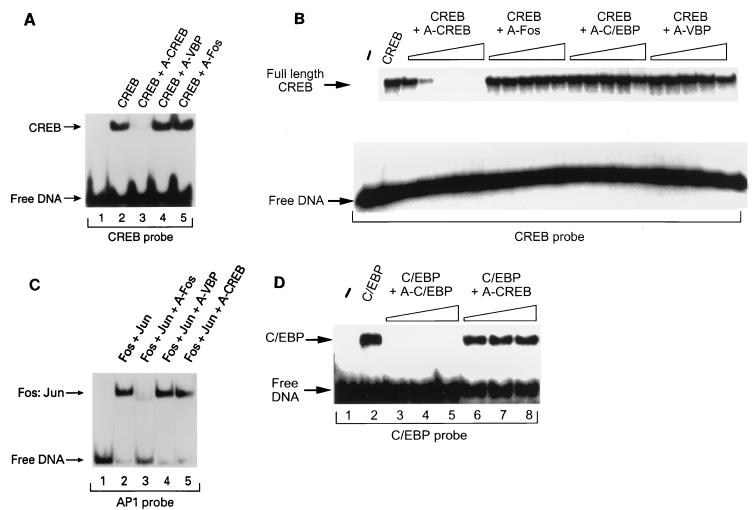FIG. 3.
A-CREB inhibits DNA binding activity of CREB. The inhibition of CREB DNA binding activity is leucine zipper specific. (A) A-CREB, but not A-VBP or A-Fos, inhibits the DNA binding activity of the DNA binding domain of CREB. An EMSA was performed with a 25-bp double-stranded DNA oligonucleotide containing a consensus CRE and the DNA binding domain of CREB (5 × 10−6 M; lane 2). The binding reaction mixture contained 1.0 molar equivalent of A-CREB (lane 3), A-VBP (lane 4), or A-Fos (lane 5). (B) A-CREB, but not A-Fos, A-C/EBP, or A-VBP, inhibits the DNA binding activity of full-length CREB. Increasing concentrations (10−8 M, 3 × 10−7 M, 10−7 M, 3 × 10−6 M, and 10−6 M) of A-CREB, A-Fos, A-C/EBP, or A-VBP were added to the reaction mixture containing CREB (2 × 10−7 M), and an EMSA was performed as for panel A. (C) A-CREB does not inhibit a Fos-Jun complex from binding to the AP-1 site. An EMSA was performed with a probe containing an AP-1 site (lane 1). A Fos-Jun complex (5 × 10−7 M) binds DNA (lane 2), and 1 molar equivalent of A-Fos completely inhibits Fos-Jun DNA binding (lane 3). Neither A-VBP (lane 4) nor A-CREB (lane 5) inhibits AP-1 DNA binding activity. (D) A-CREB does not inhibit DNA binding activity of C/EBP. An EMSA was performed with a probe containing a C/EBP binding site (lane 1). C/EBP (10−8 M) was challenged with A-C/EBP or A-CREB at 1, 3, and 10 molar excesses. A-C/EBP completely inhibits C/EBP binding (lanes 3 to 5), while A-CREB has no effect on C/EBP DNA binding activity (lanes 6 to 8).

